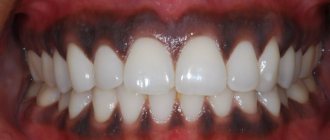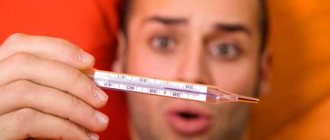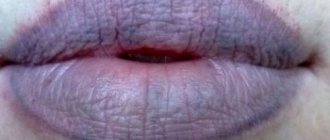Ear swelling
Edema is not a separate diagnosis. It often accompanies otitis media. It causes fluid retention and redistribution of sodium chloride.
As pressure increases in the vessels, fluid quickly accumulates, causing a similar symptom. If the problem is caused by damage to the network of lymphatic vessels, fluid leaks into the tissue.
Swelling of the concha can be observed with hematomas and perichondritis of the external ear. Often the prerequisites are mechanical damage, blows and bruises.
Swelling of the auditory tube leads to impaired ventilation and the formation of purulent processes. The tube itself becomes narrower, which leads to impaired hearing on the affected side.
Symptoms
A number of specific symptoms make it possible to diagnose otitis media. Among them, such an indicator as hearing loss becomes important only with very severe swelling of the external auditory canal. Obvious symptoms include:
- There is redness of the skin, and the outer part of the ear may swell.
- When pressing on the auricle, pain is felt.
- There is a feeling of pain when chewing, itching appears.
- Feeling of stuffiness in the ear canal.
- Increased body temperature.
- A fungal infection is characterized by severe itching and sometimes acute eczema. When examined, a gray or white coating is often detected on the skin of the ear canal.
Depending on the duration of the disease, otitis media is divided into acute and chronic. Acute is also known as “swimmer’s ear” and is manifested by bright, aggravated symptoms that quickly pass due to surgical treatment and activation of the immune system. Necrotizing acute otitis is characterized by the following manifestations:
- Severe pain accompanied by discharge from the ear.
- Edema.
- Decreased hearing function due to narrowing of the external auditory canal.
- In some cases, cellulite of the neck and face may be observed.
Chronic
The diagnosis of chronic otitis is made in cases where the duration of the disease is more than four weeks or if the disease manifests itself more than four times during the year. The chronic form occurs due to a permissive attitude towards acute otitis media. The second reason is the regular removal of the protective sulfur layer with cotton swabs and injury to the walls, which leads to inflammation. Chronic otitis media is characterized by:
- Purulent discharge from the ear.
- Autophony – resonance in the diseased ear of sounds emitted by the patient.
- Feeling heavy head
- When turning or tilting the skull, a sensation of iridescent liquid occurs.
- The constant presence of pus provokes the closure of the external ear canal with growing tissue.
One of the main manifestations of necrotizing otitis is persistent severe pain. The patient is bothered by pain in the corresponding ear, radiating to the temporomandibular joint and the back of the head. It intensifies when opening the mouth, blowing the nose and swallowing; the intensity of the pain syndrome increases at night. Characterized by severe hemicranialgia. Some patients experience tonic spasm of the masticatory muscles. Malignant otitis media is often accompanied by otorrhea. Foul-smelling yellow-green discharge flows from the ear canal.
The growth of granulations in the auditory canal causes a feeling of stuffiness in the ears and a significant decrease in hearing. Signs of general intoxication in adults are usually mild. The body temperature rises to low-grade levels, and slight general weakness is troubling. Already in the early stages of the disease, some patients develop symptoms of damage to the facial nerve. The face becomes asymmetrical, speech becomes slurred. Watery eyes appear and salivation is disrupted.
The soft tissues of the parotid region swell, the regional lymph nodes become enlarged and painful. When the pathology moves to the auricle, swelling and hyperemia are observed. In the area of the mouth of the auditory canal, red granulations that bleed at the slightest injury are visualized. Malignant external otitis in children is characterized by an acute and violent onset with febrile or hyperthermic fever. Facial paralysis occurs early and often.
Malignant external otitis media. Narrowing of the ear canal, swelling of the auricle, large amounts of exudate
Inflammation of the lymph node behind the ear
The clinical picture of external otitis will directly depend on the form of the disease, but the leading symptoms of external otitis can be identified:
- Acute ear pain.
- Otorrhea with purulent contents.
- Inflammation of the lymph nodes of the parotid region.
- Intense pain upon contact with the tragus or auricle.
Next, let's look at how the signs of external otitis differ in different forms of the disease.
It is observed when purulent inflammation occurs - a boil.
- Hyperemia and swelling of the ear wall.
- Increased body temperature.
- Acute ear pain radiating to the neck and jaw.
- Significant increase in pain when chewing, pressing or moving the auricle.
- General disturbance of the patient's condition.
- Presence of a boil.
A distinctive feature will be inflammation of the entire auditory canal.
Characteristic:
- Itchy sensations.
- Purulent otorrhea.
- Painful sensations when trying to press on a section of the ear canal.
- Minor ear pain.
- Swelling of the auditory canal itself.
- Symptoms of intoxication (fever, apathy).
Occurs when the cartilage of the auricle becomes inflamed (after injury).
Manifests:
- Pain syndrome.
- Swollen ear and lobe.
- A large amount of pus in the ear. Therefore, upon palpation, a cavity filled with liquid is felt.
- A gradual increase in pain, when touching the ear becomes unbearable.
- Poor general health (weakness, fever).
Symptoms of otomycosis
It is an infectious disease of the ear that occurs when mold fungi appear on the walls of the eardrum and external auditory canal.
Otomycosis is different:
- Congestion, noise in the ears.
- Sometimes crusts and films appear on the skin of the auricle.
- Itching and pain in the ear, sensation of a foreign body.
- Headaches may occur on the affected side.
- Otorrhea with various types of discharge.
Erysipelas is a bacterial otitis media caused by streptococci.
In this case, the following manifestations will be observed:
- Intense ear pain and itching.
- Swelling and clearly limited hyperemia of the skin.
- The temperature rises to febrile levels (39-40⁰C).
- Symptoms of intoxication (headache, weakness, chills).
- Local increase in temperature.
- Sometimes blisters containing clear liquid may form on the skin.
The severe course of such external otitis can easily turn into its chronic form.
The serous form of inflammation is relatively rare. It is characterized by a sluggish course, so patients rarely consult a doctor in the initial stages of the development of the disease. The affected ear turns red and swells. Patients note the appearance of a feeling of heat and burning in the area of the affected tissue. The skin of the ear itself acquires a characteristic glossy shine and becomes hot to the touch.
In addition, there are systemic disorders. Patients complain of constant weakness and fatigue, which, however, is attributed to general malaise and overexertion. Possible problems with sleep, decreased or complete absence of appetite, and outbreaks of irritability.
Otomycosis is a fungal infection of the outer ear
Symptoms of acute external otitis include pain and foul-smelling discharge. If the canal becomes swollen or filled with pus, hearing loss occurs. When touching or pulling the auricle, or pressing on the tragus, painful sensations may occur. In acute otitis of the external ear, examination of the external auditory canal and eardrum (otoscopy) is painful and quite difficult. This is due to the fact that the ear canal is swollen and red, and there is a lot of wet, purulent masses in it.
Otomycosis is more itchy than painful, and patients also complain of a feeling of ear fullness. The cause of otomycosis is the black mold Aspergillus niger, which can be seen by the presence of grayish black or yellow dots (fungal conidiophores) surrounded by thread-like formations (fungal hyphae).
Boils cause severe pain and may leak pus and blood over time. They appear in the form of focal erythematous edema (ulcers).
On the topic: Fungus in the ears - causes, symptoms, treatment, prevention.
Causes
The reasons that form edema include:
- injuries,
- foreign bodies,
- infections,
- allergies,
- neoplasms.
Injuries and foreign bodies
Injury can be to the outer, middle, or inner ear. To determine the treatment regimen, the cause is established. Almost always, swelling occurs due to a puncture of the lobe or cartilage. This may appear due to a cosmetic procedure or due to careless actions. Swelling of the outer ear occurs due to:
- blow,
- falling from a height,
- animal or insect bite.
Additionally, redness, hematomas, and bruises may appear.
Middle ear swelling is often associated with pressure changes within the ear canal, which causes barotrauma. Sometimes swelling occurs when a loud kiss is placed on the ear. Despite the harmlessness of many causes, they can cause significant damage to the eardrum.
Swelling of the inner ear can occur due to contusion or acoustic trauma. Usually, in addition to swelling, a number of other symptoms are observed: nausea, loss of coordination, and noise.
Pathology often occurs in athletes. Especially for scuba diving enthusiasts. If a person’s profession is associated with injury, regular hemorrhages and blockage of subcutaneous vessels occur. Often such deformations are irreversible.
How to remove a foreign body from the ear, watch our video:
Viral and inflammatory diseases
This reason is one of the common ones. Germs and viruses can lead to inflammation. This is accompanied by hearing loss and pain. The situation can be aggravated by weak immunity, insufficient amounts of vitamins in the body, and chronic diseases.
Usually the prerequisite is acute respiratory diseases that affect the nose and throat. When inflammation moves into the ear cavity, inflammation and swelling begin. First, pain appears, then general health worsens.
With otitis media in a diffuse form, a slight narrowing of the passage is detected. Then the swelling is detected already during the examination. With limited otitis, inflammation of the hair follicle occurs. In addition to swelling, severe pain appears, which increases during conversation.
Allergies
The cause of ear swelling can be an allergy. Patients may develop Quincke's edema, which manifests itself as enlargement of the entire face, cheekbones or neck. In this case, the swelling may be:
- hereditary,
- acquired,
- medicinal,
- allergic.
Sometimes a slight swelling of a pale pink hue appears. This indicates the appearance of dermatitis. The duration of such a reaction usually does not exceed 2 days.
Tumors and neoplasms
If there is a tumor or cancer, swelling may be accompanied by nausea, weakness, or bleeding from the ear. Cancer of the auricle is most often detected. With it, symptoms and swelling depend on the area of prevalence. The main symptoms are: hearing loss, pain and noise, vestibular disorders.
Swelling from a new growth may or may not be painful.
Note! Sometimes a lump behind the ear can indicate mumps. Then the child develops a headache and severe swelling of the neck.
What does a middle ear tumor look like during otoscopy:
Other reasons
Swelling may appear due to perichondritis. When the disease occurs, the cartilage tissue is affected, so the lobe is not affected. The inflammation is diffuse in nature, accompanied by redness of the skin. Additionally, a glossy shine, redness, and increased temperature at the site of infection appear.
Another reason is the formation of hematoma. The inflammatory process occurs due to hemorrhage and accumulation of blood between the membrane and the cartilage itself. Blood accumulating in the upper part of the ear leads to changes in the contours of the ear.
The photo shows ear swelling of various pathogenesis
The inside of the ear is swollen and hurts: causes, symptoms and treatment of swelling, what to do
In medicine, ear edema is a condition of the auditory organ in which various pathologies of an allergic, inflammatory or traumatic nature are observed in it, characterized by regular, impulsive pain and a feeling of congestion. Ear swelling is a process that requires urgent treatment. Neglecting it can lead to more severe complications - inflammation of the membranes of the brain and cranial bones or complete hearing loss
Internal inflammation
If a person begins to feel that the ear hurts more and more every day, then this almost always means that an inflammatory process has begun in the internal part of the organ.
The progression of infection inside the affected organ in most cases is also accompanied by a sharp increase in temperature and discharge in the form of blood with pus from the organ.
With such inflammation, the inner membrane of the ear suffers greatly.
Moderate inflammation
If the ear is swollen and the pus no longer comes out on its own, this is a sign of otitis media or middle ear disease, which is the most severe form of a serious disease.
Moderate inflammation can manifest itself as a result of untreated external inflammation.
With it, the internal tubes leading from the external concha to the eardrum, and the eardrum itself are quite severely affected.
There is an opinion that swelling of the auditory organ is necessarily characterized by severe pain in the ear. But in fact, this symptom appears only during the development of the acute form of the disease and is not its main symptom.
More accurate signs of ear swelling are:
- decreased perception of sounds and the sensation of an echo in the head during a conversation;
- characteristic redness at the site of the lesion;
- severe dizziness, fever and deterioration in general health.
When the ear is in a swollen state for a fairly long period of time, a purulent substance is released from the affected organ, accompanied by a short-term improvement in well-being and a new attack of pain after it. This mainly happens after damage to the protective membrane separating the outer and middle ear.
Pain in the damaged ear can occur during meals and when performing other manipulations that involve the use and movement of the jaw. Over time, pain from the ear can also spread to the neck, throat and nose.
Symptom Treatment Methods
Before starting treatment for swelling of the auditory organ, it is necessary to find out the basis that triggered the onset of the disease. In most cases, pharmaceutical drugs are used to eliminate the problem. Folk remedies are considered no less effective.
Traditional medicine
What exactly to do in a given situation should, of course, be decided by the attending physician. Self-medication for swelling of the ear is extremely undesirable - you can only aggravate the unpleasant situation and be left without hearing at all.
In case of infection, doctors usually prescribe antibacterial agents of general and local action: in particular, ear drops - Otipax, Otofa or Otinum.
If the drops do not help, then catheterization is carried out by inserting a special tube into the nasal cavity. The essence of the method is to instill the medicine through a pre-installed device and eliminate swelling of the auditory organ in this way.
In some cases (in particular, with barotrauma that provoked swelling of the ear), instead of the catheterization procedure, the eustachian tube may be blown out with special equipment. It helps normalize the pressure between the nasal cavity and the middle ear and thus eliminates swelling in the auditory organ.
When the body is intoxicated, non-steroidal drugs and various therapeutic procedures are usually used to eliminate the inflammatory process - treatment of the affected area with ultraviolet radiation from a quartz or bactericidal lamp, therapy with electrical impulses, exposure of the diseased organ to a large high-frequency electromagnetic field or static magnetic field.
It is worth noting that these methods of therapy are absolutely safe and can even be used to treat swelling in women who are pregnant at any stage.
If the cause of ear swelling is an allergy, then in this case doctors prescribe anti-allergy drugs - Suprastin, Tavegil or their analogues.
Traditional methods
Traditional recipes, prepared in ordinary home conditions, also quickly eliminate discomfort in a swollen organ. Here are some of them.
Salt compress
You need to heat a little salt over high heat and then pour it into a regular clean sock. An improvised compress must be applied to the affected organ. It will warm up the diseased area and stop the development of the pathological process in the ear.
Compress made from plantain or cabbage leaves
You need to take one of these ingredients and apply it to the sore ear for a couple of hours. The compress should be secured on top with a retaining bandage. After the time has passed, the used sheet should be replaced with a new one.
Bay tincture
To prepare the product, you need to thoroughly chop the bay leaf, pour boiling water over it and leave to infuse for 45-60 minutes until the infusion acquires a pronounced yellow color. The resulting tincture should be used to moisten a cotton ball, which is subsequently introduced into the damaged organ.
To wet a cotton swab, you can also use a mixture of essential oils of eucalyptus, lavender, medicinal sage and tea tree. You can also drip horseradish juice into the damaged ear. It helps restore damaged tissue by accelerating the movement of blood in this area.
Important! Folk recipes should be treated with caution by those people who are prone to allergic reactions to certain products included in their composition.
Provoking factors
Provoking factors are internal and external. The first are diseases. For example, with a disease of the nasopharynx, bacteria enter the child's ear, causing swelling. External factors include sports, mechanical, chemical and other damage.
Swelling resulting from the influence of one of the factors causes pain, and sometimes, with improper treatment, the situation can become more complicated. Then a more serious impact will be required.
Folk remedies for ear congestion
It often happens that an unpleasant sensation appears in the ears, but it is no longer possible to get to the doctor. The only reason to call an ambulance can be a sharp pain in the ears and increased body temperature. And if only mild congestion bothers you, the problem can be eliminated using folk methods.
Ear wax can be easily removed with simple hydrogen peroxide. To do this, you need to use a 3% solution. A few drops of peroxide are dripped into the ear and wait until the wax dissolves. After a few minutes, the solution can be removed from the ear. Your hearing will improve significantly.
Everyone should know how to relieve congestion using medicinal herbs. A simple one will do. It is very easy to prepare. A few spoons of dry chamomile are poured into a liter of boiled water. After a few hours, the infusion can already be used. Chamomile can be used to rinse the ears for otitis media. In this way, you can not only remove congestion, but also stop the development of the inflammatory process.
The feeling of stuffy ears is well known to those who have taken to the air on board an airplane at least once in their lives. During takeoff and landing, due to rapid changes in external air pressure, internal pressure occurs on the eardrum, tinnitus appears, and hearing decreases. A person begins to hear sounds as if through thick water. Some time after the pressure equalizes, the unpleasant symptom goes away. But what if it occurs suddenly and for no apparent reason? How to relieve ear congestion on your own and how to treat it?
Diagnostics and necessary research
If swelling occurs, you should seek medical help. He will conduct a visual inspection of the outer ear and surrounding tissue. The correctness of the anatomical structure is assessed. In this case, swelling may also appear behind the ear.
The second method is otoscopy. Using a special device, a beam of light is directed to the middle sections. This allows us to identify the locality of the lesion. Sometimes palpation is also performed using a special button probe.
The latter looks like a metal rod that is curved at both ends. In rare cases, a radiation diagnostic method is prescribed. It allows you to see damage to the inner ear, brain, and also identify the nature of the development of swelling.
Symptoms of ear allergies
Any allergic reaction is accompanied by redness of individual areas, peeling and itching. The affected areas are very itchy; people scratching these areas can injure the skin, which can lead to infection and, as a result, an inflammatory process.
Therefore, especially in childhood, if redness or rash appears on the ears, you should immediately contact your pediatrician.
Moreover, red spots, lumps or rashes in the ear area are not always a sign of an allergy. For example, a plaque-like rash may be a sign of discoid lupus erythematosus, psoriasis, or seborrheic dermatitis. Nodular redness is a sign of a malignant tumor.
Keratinous, red areas on the ears of adults can cause actinic keratosis, solar keratosis, and thickened and indurated areas on the ears can cause chronic itchy dermatitis.
Sometimes allergies are accompanied by blocked ears. In this case, you should immediately seek professional help, because this symptom may indicate the presence of purulent otitis media.
Treatment
Ear swelling can be relieved:
- medicinally,
- physiotherapy,
- folk remedies.
Medication
The course of exposure depends on the cause of the disease. Are used:
- Antibacterial drugs.
- Antifungal drugs.
- Anti-inflammatory ointments.
The administration of liquid drugs can occur using the catheterization method through the nasal cavity or by administering the drug through the pharyngeal opening of the auditory tube. At the same time, treatment of diseases of the nasopharynx is carried out in order to avoid re-entry of the infection and its spread in the ear.
Vasoconstrictor ear drops are often prescribed. This helps relieve swelling. These include Otrivin, Tizin, Naphthyzin. But the dosage and frequency of such drugs are selected exclusively by the attending physician.
Physiotherapy
To relieve symptoms, electrophoresis is prescribed. Thanks to the current, the active components of the drugs penetrate into the deepest tissues, causing cells to regenerate faster. Positive dynamics are observed with UHF, microwave and when using various inhalations.
Physiotherapy has an anti-edematous and anti-inflammatory effect. The rate of penetration of pathogenic microorganisms decreases, various blood parameters improve. When treated with these methods, recovery is faster.
Folk remedies
Many doctors recommend using propolis. The tincture is made: 1 tbsp. l. propolis is poured with 100 ml of alcohol. The mixture must be infused for several days in a dark and cool room. Then it remains to moisten the gauze and insert it into the ear. The course of treatment is 2 weeks.
Compresses based on camphor oil and boric alcohol can be used. These components must be used only after consulting a doctor. This is due to the fact that for some diseases their use is unacceptable.
If swelling has just appeared, then warm salt will help. It is heated in a frying pan and then wrapped in gauze. The compress is kept until the salt cools. The procedure should be carried out several times a day.
For more information about medicinal and traditional methods of treating inflammation and swelling of the ear, watch our video:
How is ear congestion treated?
Initially, the specialist must determine the location and form of the disease. Based on this, complex treatment is prescribed. Diseases caused by bacterial infections can only be treated with antibiotics. Additionally, ear drops are used for ear congestion. They make it possible to alleviate the patient’s condition much faster.
If the cause of congestion is cerumen, the problem can be resolved as quickly as possible. The doctor removes the plug mechanically and prescribes special drops to avoid the inflammatory process.
During the period of seasonal temperature changes, many are interested in the question of how to get rid of congestion in the ears due to a cold. Treatment must be comprehensive. It should include antiviral therapy, drugs that stimulate the immune system, as well as auxiliary agents to alleviate the patient’s condition. Ear drops for ear congestion during a cold will help the patient faster. But this remedy cannot cure a cold. Below we will present the drops that are most often recommended by ENT doctors.
Possible complications
If ear swelling occurs, you should immediately consult a doctor. In some cases, for example, with Quincke's edema, this can lead to death. Popular complications include the development of hearing loss and deformation of cartilage or tissue.
One of the most severe complications is the spread of pathogenic microflora to the bone structures of the skull or meninges.
Ears get wet inside - how to get rid of moisture in the ears
If your ears are very itchy and wet inside, you should immediately go to the doctor.
Sputum and itching in the ears are symptoms of complex and unpleasant diseases that are difficult to cure in an advanced stage. Ear pathologies should not be treated negligently; if treatment is delayed or left untreated, hearing can significantly deteriorate. Only a medical specialist can determine exactly what disease is causing moisture to accumulate in the ears, based on the patient’s tests.
Causes of pathology
Weeping and itchy ears are not always a sign of a complex illness that requires intensive care. If sputum inside the ears appears for a short time and is not characterized by abundance, then, most likely, particles of dirt or other harmful substances are irritating the ear canals.
If your ears itch unbearably and fluid flows out of them profusely, then you should not delay your visit to the doctor. Most often, excessive moisture inside the ears is a symptom of the following diseases.
- Otomycosis. This refers to infection of the ears by a pathogenic fungus. Pathogenic microorganisms can penetrate both one ear and two at once; they can invade the tissues surrounding the ears. The skin affected by a fungal infection is very itchy and covered with a gray or yellowish coating. With otomycosis, fluid flows intensely from the ears.
- Eczema. The second name of the disease is versicolor. The disease first affects the ears and scalp behind the ears, then penetrates the ear canals. With eczema, redness of the skin is observed, and after a while a rash appears. When the blisters that dot the skin burst and release fluid, a thin crust gradually forms in their place.
- Otitis. When an inflammatory process develops in the ears, a liquid called exudate may be released from the capillaries that penetrate the ear canals. If pus begins to come out of the middle ear during otitis media, itching and pain decrease, then the eardrum has ruptured.
- Allergy. Quite often, moisture in the ears is an allergic reaction of the skin to the metal that forms the basis of earrings or piercings.
Diagnostics
To find out what disease is causing your ear to be wet, you need to see an otolaryngologist. If the doctor detects in the patient, in addition to moisture in the ears, redness and rashes on the skin of the ears, then he sends the sick person to a dermatologist.
To diagnose the pathology, the patient must donate blood for analysis and make a smear of the affected skin. Based on the results of a laboratory study of biomaterial samples taken, the doctor determines the disease of the hearing organs.
If a fungal infection multiplies in the ears, then the type of microorganisms must be determined in a medical laboratory. Each type of fungus is destroyed by a specific antifungal medication. If the cause of moisture in the ears is eczema or an allergic reaction, then it is necessary to identify irritants or allergens and prevent the sick person from coming into contact with these substances.
The development of otitis is indicated by pain in the ears, leakage of pus from the ear canals, hearing loss, migraines, noises in the head, and increased body temperature.
Treatment methods
The method of therapy is chosen by the doctor based on the cause and duration of the disease. Ears are usually treated with medication and physiotherapeutic procedures, but in some cases surgery may be required. During the period of therapy, a sick person should eat properly and nutritiously and strengthen the immune system.
Treatment of eczema
In case of weeping lichen, it is necessary to clean the ears every day and treat the skin with antibiotic medications to prevent the proliferation of pathogenic bacteria. The method of treating eczema is selected taking into account the stage of development of the disease.
For weeping wounds, the skin of the ears is regularly treated with hydrocortisone ointment or oxytetracycline hydrochloride. When peeling the skin, ointments are used that have anti-inflammatory, vasoconstrictor and antipruritic effects.
They should treat the ears twice a day for three or four weeks. The crusts on the skin are smeared with Vaseline to soften them, then anti-inflammatory and antibiotic ointments are applied to them. Treatment of eczema is carried out in stages and includes the following steps:
- eliminating the irritant;
- relieving nervousness with sedatives or herbal drinks;
- normalization of nutrition, exclusion of sweets, spices, fatty foods;
- taking antihistamines, using anti-inflammatory ointments;
- disinfection and drying of wet wounds after rupture of blisters;
- reduction of itching and easier removal of crusts.
In some cases, the doctor may prescribe glucocorticoids to the patient. A sick person must take vitamins and immunostimulants to maintain normal functioning of the immune system. Eczema can be treated quite successfully using traditional medicine. 20% propolis extract helps to reduce inflammation of the skin.
Damaged areas of the skin are treated with the solution, after which propolis ointment is applied to them. To dry and tighten the wounds left after bursting blisters, it is recommended to use potato or carrot juice, or an infusion of walnut shells.
Treatment for fungal ear infection
If an adult’s ear becomes wet due to the proliferation of a pathogenic fungus, then it is necessary to take a skin smear to determine the type of infection. Based on the laboratory test results, the doctor prescribes the most appropriate antifungal medicine. Treatment for a fungal infection is quite long, sometimes stretching for several months.
Since antifungal medications negatively affect the body, during therapy a sick person must take vitamin complexes. The skin affected by the fungus is very itchy, but you should not scratch your ears, otherwise you can transfer the infection to healthy tissue.
Most often, topical medicinal solutions are used to destroy the fungus:
- Pimafucin,
- Clotrimazole,
- Lamisil,
- Levorin.
These medications can be instilled into the ears, or you can put cotton wool moistened with them into the ears several times a day for 15 minutes. Nystatin and Mycospor ointments, Travogen and Pevaril creams effectively kill fungal infections.
If the disease worsens, the fungus multiplies too actively, then the doctor may prescribe antifungal drugs for oral use: Diflucan, Intraconazole. You can try treating the fungus with folk remedies, although it is unlikely that you will be able to completely get rid of the disease, but it is quite possible to relieve the painful symptoms.
It is recommended to drip two or three drops of onion juice into your ears in the evening before going to bed; it is also useful to treat the affected skin with an infusion of chamomile, apple cider vinegar, and a decoction of bird cherry and bay leaves.
Article on the topic - names of the best ear drops.
Treatment of otitis media
Otitis, accompanied by itching and inflammation of the skin, is treated with a large list of medications: antibiotic, anti-inflammatory, vasoconstrictor, antiviral medications. The goal of therapy is to normalize the functioning of the auditory tube and destroy pathogenic microorganisms.
If your ears hurt a lot with otitis media, your doctor will prescribe painkillers. In some cases, the eardrum is punctured and boric acid powder is injected into the middle ear.
An article on the topic - what antibiotics treat otitis media.
Allergy treatment
If mucus in the ears is formed due to the irritating effects of hearing aids, earplugs, earrings or other metal accessories, then the allergen must be disposed of immediately. The allergic reaction is eliminated with antihistamines.
Correct and timely treatment of excessive ear moisture prevents the occurrence of chronic ear diseases, weakened hearing, and the penetration of infection into the inner ear and brain.
If moisture appears in the ears, it is forbidden to self-medicate or ignore the advice of a medical specialist. Only a doctor can choose the optimal treatment method.
Attention, TODAY only!
Source: https://LOR-explorer.com/ear/moknut-ushi-vnutri
Features of the clinical picture of purulent inflammation
Purulent inflammation of the auricle is much more dangerous, but at the same time a more common pathology. Systemic disorders are more pronounced: there is a sharp increase in body temperature, the appearance of weakness, chills, muscle weakness, and body aches.
The auricle becomes very swollen and red, and as pus accumulates, it even acquires a bluish, even purple tint. Visible nodules and tubercles form on the cartilage. Any touch to the auricle is accompanied by attacks of intense pain, which is localized not only in the ear, but also radiates to the temples, neck, and back of the head. If the ear cartilage softens and the tissue begins to peel off, you may notice that the skin of the ear wrinkles and the shell itself decreases in size.
You should not ignore such symptoms and hope that everything will go away on its own - in this case, every minute is worth its weight in gold, because it is very important to start therapy on time.












